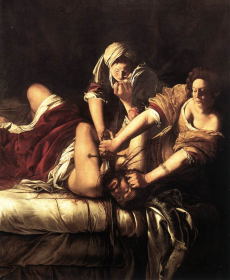
Artemisia Gentileschi’s famous work ‘Judith Slaying Holofernes,’ is an oil on canvas work, completed in 1618, depicting a Biblical tale from the Old Testament, with a General being slain by an Israelite, Judith. The topic was popular within the Renaissance, and was covered by many artists, such as Caravaggio, the artist’s work whom Gentileschi’s piece was thought to be inspired by. However, Gentileschi’s piece stands out from others and has a sense of ‘otherness’ due to its stylistic differences and composition.
The lighting of the piece of somewhat different to that of others, with the corners of the painting and around the figures being black, with no light source visible, yet there is white light upon the edge of the bed, upon Holofernes, and just reaching the faces of the two women. The unnatural light creates a feeling of eeriness, and somewhat displaces the scene, putting it in a ‘spotlight.’ It rather morbidly draws us in to observe a man’s murder. The shadows subsequently cast upon the women’s faces not only makes them look strong, but somewhat evil; Gentileschi flips the conventional ideas of women, and presents these two powerful and vengeful women.
Equally, the focus seems to be on Holofernes’ face; his is the only face we can see clearly, and even in this moment of his death, we see his eyes open; his dying expression. This is one of the ways Gentileschi’s painting is much more violent and brutal than other depictions of the scene. Art historians have suggested this may be as a result of Gentileschi being raped by her ‘mentor’ Tassi, and the humiliation she suffered at the trial. Subsequent to the event, we see a number of Gentileschi’s works depicting Biblical tales and myths for example. But often in a very gory way, with powerful women emerging as victors. However, some argue that it isn’t fair to attribute all of her art to this, as it is a very reductive view of her artwork and motives, yet, I think in this instance, the rape may well have influenced her; we see the man and woman in the opposite scenario here. The man is the vulnerable one, swathed in bedsheets and nothing more, and the women and wearing lustrously textured dresses in bold colours befitting nobility, implying power with the vivid red and blue. The way Holofernes’ face is forced to front of the image making us look at him, is similar to the idea of the woman being looked at after a sexual incident, wherein she is vulnerable and we observe her terror, but here, we are seeing the women very much in control and Holofernes as a ‘victim.’ In other renditions of the scene, the colours are more muted, mainly browns, such as in Jean de Boulogne Valentin’s work, and the women are far less dominant, often looking away as if they shouldn’t be there. Whereas Judith and her handmaid are incredibly purposeful in Gentileschi’s piece, eyes fixated on the act, reinforcing the idea that this picture may in fact be allegorical, serving as a form of catharsis for Artemisia, allowing her to ‘act out’ her vengeance, and vent her rage at her assault.
The blood seeping down the bed also adds to the sense of ‘otherness’ at it creates an odd feeling; we are witnessing something incredibly brutal and it seems normal; the blood is drying and we are doing nothing about it. It is also in a sense, a reflection of our own mortality; we will all die one day, and our blood will dry up; Artemisia is offering us the idea that no one is invincible.
Overall, Gentileschi’s piece is very powerful, somewhat due to its feeling of ‘otherness.’ The concept that it may well be allegorical aids this substantially, as it distances us from reality. Equally, the sheer brutality and harsh lighting, coupled with the vibrant colours, which contrast to the cadaverous skin tone of Holofernes makes this a very difficult painting to look at, especially as she confronts you with a dying man’s face; and yet, it is ‘safe’ for us to observe such horrors, as we are being fed it in the form of a Biblical narrative, which to us is like a fairy tale with only good and evil, good triumphing.
Image: http://www.wikiart.org/en/artemisia-gentileschi/judith-beheading-holofernes-1620

0 Comment:
Be the first one to comment on this article.